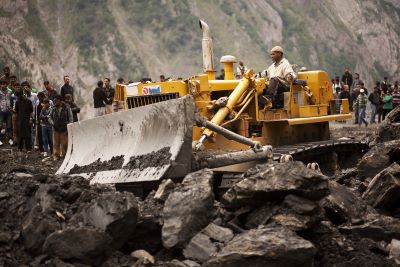Context-
India, as a vast country, faces a multitude of natural disasters that have increased in frequency and severity due to climate change. From cyclones to earthquakes, floods to heat waves, the country's diverse geography exacerbates these risks. In response, India has established a comprehensive framework for disaster management, bolstered by legal mandates, institutional structures, and international commitments.
Legal and Institutional Framework
Disaster Management Act of 2005
The Disaster Management Act of 2005 provides the foundation for disaster management in India. It establishes a hierarchical structure involving national, state, and district levels to effectively handle disasters.
● National Disaster Management Authority (NDMA): Headed by the Prime Minister, NDMA formulates policies, plans, and guidelines for disaster management, addressing both natural and man-made disasters.
● National Executive Committee (NEC): Assists NDMA in policy implementation, chaired by the Union Home Secretary, and coordinates national disaster response efforts.
● State Disaster Management Authority (SDMA): Led by the Chief Minister, SDMA implements state-level disaster management policies, integrates mitigation measures, and coordinates with NDMA.
● District Disaster Management Authority (DDMA): Managed by the District Collector and a Co-Chairperson, DDMA implements local disaster management plans and ensures compliance with national and state guidelines.
● Local Authorities: Includes Panchayati Raj Institutions, Municipalities, and other bodies responsible for capacity building, relief operations, and preparation of disaster management plans.
Key Institutions
● National Institute of Disaster Management (NIDM): Focuses on capacity development, training, research, and documentation in disaster management under NDMA's guidance.
● National Disaster Response Force (NDRF): Specialized force under NDMA's command, comprising battalions strategically positioned across India for rapid response to disasters.
Committees and International Commitments
● Cabinet Committee on Management of Natural Calamities (CCMNC): Oversees natural calamity management, suggests preventive measures, and promotes public awareness.
● International Commitments: India is committed to frameworks like the Sendai Framework for Disaster Risk Reduction (SFDRR) and the Hyogo Framework for Action (HFA), aimed at reducing disaster risks through sustainable development and preparedness.
Current Major Disaster Threats in India
India faces a range of natural and man-made disaster threats:
Natural Disasters
● Floods: Annual monsoon floods affect millions, with states like Bihar and Assam being particularly vulnerable. Glacial Lake Outburst Floods (GLOFs) add to flood risks.
● Cyclones and Storms: Coastal areas along the Bay of Bengal and Arabian Sea are prone to cyclones and tsunamis, exemplified by Cyclone Fani and recent events like Cyclone Biparjoy.
● Earthquakes: India's seismic zones make it susceptible to earthquakes, with recent significant events in Mizoram and Sikkim highlighting the risks.
● Droughts: Erratic rainfall patterns lead to severe droughts impacting agriculture and water resources, affecting states like Maharashtra.
● Landslides: Hilly regions experience landslides during heavy rains or earthquakes, such as those in Himachal Pradesh and Manipur.
● Heat Waves: Rising temperatures result in prolonged heat waves across the country, posing significant health risks.
Man-made Disasters
● Forest Fires: Human activities contribute to forest fires, affecting states like Himachal Pradesh and Goa.
● Industrial and Chemical Accidents: Industrial growth increases the risk of accidents, as seen in incidents like the chemical spill in Surat and the Visakhapatnam gas leak.
Factors Exacerbating India’s Disaster Risk
Several factors contribute to heightened disaster risks in India:
● Urbanization and Unplanned Development: Rapid urban growth without proper planning increases vulnerability to floods and other disasters.
● Climate Change: Changing climate patterns amplify the intensity and frequency of natural disasters like cyclones and floods.
● Aging Infrastructure: Deteriorating infrastructure, such as dams and buildings, coupled with inadequate maintenance, raises disaster risk.
● Environmental Degradation: Deforestation, mining, and unsustainable land-use practices contribute to landslides and soil erosion.
● Industrial and Technological Hazards: Industrial accidents and chemical disasters pose significant risks due to the growing industrial sector.
Measures to Reduce Disaster Risk and Enhance Preparedness
To mitigate these risks and enhance preparedness, India should adopt the following measures:
Infrastructure and Early Warning Systems
● Dedicated Disaster Response Corridors: Develop resilient road, rail, and air corridors for emergency response access during disasters.
● Disaster-Resilient Infrastructure: Mandate resilient design and construction principles for critical infrastructure to withstand disasters.
● Multi-Hazard Early Warning Systems: Enhance early warning systems using advanced technologies for timely alerts on cyclones, floods, and other hazards.
Sustainable Practices and Capacity Building
● Disaster-Resilient Agricultural Practices: Promote drought-resistant crops and sustainable farming techniques.
● Ecosystem-based Disaster Risk Reduction (Eco-DRR): Protect and restore natural ecosystems to serve as buffers against disasters like floods and landslides.
● Capacity Building and Institutional Strengthening: Invest in training, resources, and permanent workforce for effective disaster response and management.
Public Health and Community Resilience
● Mental Health Support: Include mental health professionals in disaster response teams to address trauma and stress among survivors.
● Community Engagement: Educate communities on disaster preparedness and response through public awareness campaigns.
Conclusion
India faces a complex landscape of natural and man-made disaster risks, exacerbated by climate change and rapid urbanization. By implementing robust disaster management frameworks, enhancing infrastructure resilience, and promoting sustainable practices, India can reduce vulnerabilities and improve its disaster preparedness and response capabilities. Continuous investment in technology, capacity building, and community resilience will be crucial in safeguarding lives and mitigating the impacts of future disasters.
|
Probable Questions for UPSC Mains Exam- 1. How has India's legal and institutional framework for disaster management evolved since the enactment of the Disaster Management Act of 2005, and what are the key challenges in its effective implementation across national, state, and local levels? ( (10 Marks, 150 Words) 2. Considering the diverse range of natural and man-made disasters India faces, what specific strategies and technologies are being prioritized to enhance early warning systems and disaster preparedness nationwide? (15 Marks, 250 words) |
Source- Down to Earth







